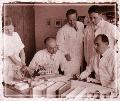DMT-Nexus member

Posts: 4639 Joined: 16-May-2008 Last visit: 24-Dec-2012 Location: A speck of dust in endless space, like everyone else.
|
I didn't know that this taar-receptor thing was actually proven.
I will read the other articles on the erowid link.
|
|
|
|
|

DMT-Nexus member
 
Posts: 1139 Joined: 14-Jul-2008 Last visit: 01-Apr-2017 Location: USA
|
Cool man. Yea it is not that well known as the TAAR are a recent discovery. If you are interested I can post some sources regarding TAAR1 binding. These compounds result in cAMP production via TAAR1. Also which is fascinating although its relavance is unknown is that 5-MeO-DMT has low potency at TAAR1, whereas DMT has significant. Although other non-visaul drugs also have high potency like MDMA and amphetamine. Check out the articles and if you want to know of some other articles let me know. Activity at other TAAR sites are not known although they are likely to be similaur as the active sites share some structure. There are actualy 3 classes of TAAR receptors split up based on there active site structure. Other unknown sites may also play a role, many prominent HA researchers like Dave Nichols, have said that the 5-HT2a theory can not explain everything. More research needs to be preformed unfortuently, because of legal restrictions, social views many researchers doing TAAR research don't even look into the endogenous hallucinogens.
|
|
|

DMT-Nexus member
  
Posts: 3555 Joined: 13-Mar-2008 Last visit: 07-Jul-2024 Location: not here
|
Quote:Furthermore plently of 5-HT agonist exist which have NO hallucinogenic effects at all (lisuride...). Is this compound specific for a certain subtype of 5-HT receptors? Most psychedelics seem to focus on the 5-ht2a subtype I believe. But yes its very true that most drugs interact with a number of receptors some stronger then others etc. TAAR receptors should provide some interesting clues as well. I just wonder why some psychedelics have visuals and some don't etc. I think the more receptors identified in this process the more a picture of how a psychedelic drug alters perceptions will come about. Could it also have to do with not just receptor binding but compound distribution. What I mean is that often we find compounds and they bind to a receptor and even if another compound binds to the same receptor with similar affinity we see drastically different effects. This could be because they are binding to other receptors and or they have different pharmacokinetic profiles but also it could be a result of how these compounds distribute and where they concentrate in the brain. Any evidence or examples for such varying distribution of compounds in the CNS? I have been thinking about this for a while but have not looked into it yet.
|
|
|

DMT-Nexus member
 
Posts: 1139 Joined: 14-Jul-2008 Last visit: 01-Apr-2017 Location: USA
|
I meant 5-HT2A agonists. Lisuride is a 5-HT2a and 5-HT1a agonist it also causes headtwitch response (HTR) in mice. The HTR is corelated with HA activity in humans although DMT does not cause HTR. Thus both false negitives and false positives exist with the HTR. HTR is mediated by the 5-HT2a receptor as knock mice and antagonist studies have shown. Thus why lisuride is non-HA is a mystery. There are other possibilities which get complex that I will not go into however it seems without a doubt other non-5-HT2a sites are important in the HA effects.
Distribution in the brain is likely to be fairly similaur for almost all these compounds if not identical small differences may arrise (from reuptake, transport) but would likely not be significant. Thus it is much more likely that the effects are a result of direct activity on receptors and that the differences in effect will be explained by different pharmacological action on receptors/enzymes.
|
|
|

DMT-Nexus member
  
Posts: 3555 Joined: 13-Mar-2008 Last visit: 07-Jul-2024 Location: not here
|
Interesting. So then lisuride has never been tested in human subjects? Mouse twitching isn't a good model for hallucinating if you ask me. But then again that's always an issue with animal studies.
|
|
|

DMT-Nexus member

Posts: 14191 Joined: 19-Feb-2008 Last visit: 22-Nov-2025 Location: Jungle
|
well yes different receptors and all sorts of processes are implicated in psychedelic effects
even though 5-ht2a does not explain all, I think its pretty clear it is a main component or pathway for the effects, due to the fact that when 5-ht2a antagonist (ketaserin was the case I think) is administered, the psychedelic effect is blocked.
I always imagine the neurotransmitters and receptors as the trucks and roads or tunnels through which 'stuff' gets transported. But talking about the trucks or the tunnel bears no significance for what the truck is carrying, which is much more dynamic.
So if for example the truck carrying food for a town does not reach the destination because the tunnel on the way is blocked (by ketaserin, for example), and then people start starving, then one could say: 'see, this truck and tunnel are responsible for those people's digestion. But then if the tunnel is liberated, and another truck passes, this time carrying toys, and then one could suppose that now the people are gonna start eating, but no, it doesnt happen as predicted, the truck did pass in that exact place but it had nothing to do with digestion, it was toys for the kids (like when this lisuride goes to 5ht2a but does not have hallucinogenic properties)
It seems to me that even though neuro transmitters and receptors are very interesting to study, they are still a VERY crude way of looking at things. The brain is so complex and full of these microtubules and microfilaments, and all this flow of electro magnetic patterns, blood flow, and in general a very complex organization, that looking at one thing at once can never explain the whole story.
I dont think we are going to 'catch' so soon the exact workings of the brain, and the why and how each substance works in the brain.
am I making any sense?
|
|
|

DMT-Nexus member
Posts: 5826 Joined: 09-Jun-2008 Last visit: 08-Sep-2010 Location: USA
|
Yeah. That's a nice way to put it. The effects are far more complex than our current understanding of them. To this day no one has been able to accurately predict the hallucinogenic effects of a new compound without testing it on a human! The same is true for almost all drugs. Our current understanding of how drugs work is still very limited. A lot it is still just theory. For example, bufotenine SHOULD NOT WORK. But it does. According to our current understanding, it cannot cross the blood brain barrier so it cannot produce hallucinogenic effects. But in reality it does produce hallucinogenic effects and is stronger than DMT. 5-MeO-DMT in theory should be much stronger than bufotenine, but when smoked, the potency is about the same, which no one has been able to explain adaquately. We still have much to learn about how these drugs actually work. You may remember me as 69Ron. I was suspended years ago for selling bunk products under false pretenses. I try to sneak back from time to time under different names, but unfortunately, the moderators of the DMT-Nexus are infinitely smarter than I am.
If you see me at the waterpark, please say hello. I'll be the delusional 50 something in the American flag Speedo, oiling up his monster guns while responding to imaginary requests for selfies from invisible teenage girls.
|
|
|

DMT-Nexus member
Posts: 85 Joined: 09-Dec-2008 Last visit: 15-Apr-2019
|
Quote:even though 5-ht2a does not explain all, I think its pretty clear it is a main component or pathway for the effects, due to the fact that when 5-ht2a antagonist (ketaserin was the case I think) is administered, the psychedelic effect is blocked. nice, but couldn't ketaserin be an antagonist of TAAR receptors too?
|
|
|

DMT-Nexus member
 
Posts: 1139 Joined: 14-Jul-2008 Last visit: 01-Apr-2017 Location: USA
|
SWIM would not say bufotenine produces effects "stronger" than DMT. Many people would disagree with this who have taken high doses of both. Not that bufotenine isn't intense but the effects are very different and many people do not get as significant visual as they do with DMT. SWIY seem to be rather unique in this regard 69ron.
Ketanserin could absolutely be an antagonist of the TAAR receptors too, in fact this is very likely as the active sites are nearly identical. A lot of further testing needs to be done. We know so very little about these amazing effects.
|